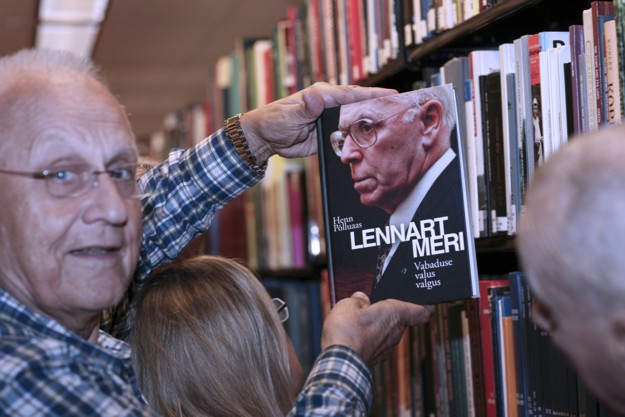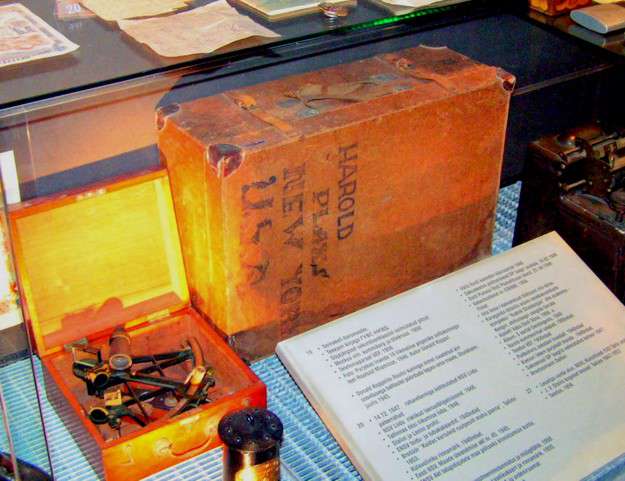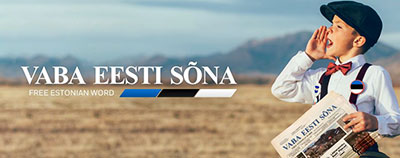
In the photo Arved Plaks
Thoughts Inspired By The Conference At The Stanford University On June 27 Concurrent With LEP-ESTO
One advantage of living in hot Texas is this. On my way to San Francisco I did not finish my cup of coffee by time I arrived at the airport parking lot. But when I returned a week later from ESTO, the coffee in the car was just as hot as when I left it.
The flight path took the plane over Palo Alto. The Stanford University campus as viewed from the air was beautiful. I spent there most of the following day. The university hosted a conference on “collecting, preserving and researching Estonian cultural heritage abroad.” Of these three themes the collection seemed to need most urgent attention.
The collection would have to focus on materials from people who escaped in 1944 and took with them items that would not survive a Soviet occupation and needed to be preserved until their return home. The escapees took documents, photographs, folk costumes; teachers took text books. But now, over half a decade later much of such materials may have been already lost or dispersed or destroyed.
On the way to the conference I recalled that it was wonderful that forward-looking people in many parts of the continent years ago took steps to preserve the past. In 1979 in Seattle Taimi-Ene Moks, Mart Kask, Anne Urv-Wilson and Jim Wilson formed the Estonian Heritage Collection. They collected textiles, jewelry, artwork in wood and leather, printed and handwritten material, etc.; in other words, everything made in Estonia or in refugee camps of Germany and later carried to this continent. We mounted many displays in local museums and even shopping centers to acquaint Americans with Estonia’s sad history. The collection was stored at several places, but finally in Seattle’s Nordic Heritage Museum. However the museum would not accept the collection permanently since it was felt that we were not tied enough to Scandinavians. Due to the lack of interest by the general public, other museums and archives in the US were ruled out. When In 1992 Estonia was free again, the collection was sent to the Estonian National Museum in Tartu, Estonia.
The conference at the Stanford University was arranged by Ms. Liisi Eglit, the newly appointed assistant curator for Estonian and Baltic Studies at the university. For the conference Ms. Eglit assembled top experts on heritage preservation from Estonia, Canada and the U.S. More than a third of the conferees were presenters giving the impression that the presenters were “preaching to the choir.” So to the three themes: collecting, preserving and researching we may expect a fourth theme explored in the future: how to get the expatriate community to look into their closets and attics for collectibles. With the shrinking newspaper subscriptions the newsletter of the Estonian National American Council has the widest circulation in the U.S. Estonian community. Perhaps it can help to spread the word in the U.S. On the subject of what to collection the talk by Tõnis Lukas was of greatest value for those desiring to help. Tõnis Lukas is the director of the Estonian National Museum (ENM). He showed many examples of items now in the ENM collection in Tartu. He summarized what constitute as collectibles of interest to ENM: all original documents or objects related to Estonian cultural activities generated as refugees or brought from Estonia.
One item shown that perked the author’s interest was the robe of a judge contributed by Alfred Viilu. Little did I know of the importance of this robe when he lived in our apartment in Danbury, CT in the 1950’s! Luckily it found its way to ENM before his death. Some examples of items that have been accepted by the Museum of Occupations in Tallinn are tools for leather craft, home-made suitcases, and bracelets.
Where to obtain help related to collecting was addressed by Ms. Piret Noorhani. She is the principal archivist of the recently formed Museum of Estonians Abroad and the Center of Estonian Studies in Toronto, Canada. She praised the overseas Estonian communities for their work done in collecting items of our heritage. She said that help and advice for this work may be obtained from members of the Baltic Heritage Network (BaltNet), which is an umbrella organization for organizations engaged in our heritage preservation. BaltNet provides instruction, workshops and seminars and maintains a web page www.baltnet.net for people seeking more information.
For information Ms. Noorhani may be contacted directly at [email protected]. She encouraged the conference participants to continue collecting heritage related items and to find reliable places for their preservation.
Mr. Taavi Kotka of the Estonian Ministry of Economic Affairs and Communication wondered about the materials that are coming into existence now (Facebook, social media etc.) and the new challenges it poses for the memory institutions who have to figure out how to collect that kind of new material.
Preservation work of collections often face the challenge of funding. Cataloguing of new material and storing objects requires space and trained personnel. It was recommended that donors first contact recipients before transferring the collectibles. It is also important that the context into which the items are placed be considered.
One significant source for funding preservation has been the Kistler-Ritso Foundation. It funded the creation of the Museum of Occupations in Tallinn, which, as the name implies is focused on collecting of items related to the period of occupations. The foundation also funded the curatorship of Ms. Eglit at the Stanford University and the hosting of a collection of Estonian literature and written documents. The Kistler-Ritso Foundation was established by Olga Ritso-Kistler and her husband Walter Kistler. His genius in support of the U.S. space exploration effort allowed him to earn monetary rewards with which the foundation was established.
Also significant is the creation of the Museum of Estonians Abroad (VEMU) allowing collections in Canada to remain close to its sources. Of course, the financing of collection in state owned museums in Estonia by the government must be applauded.
The importance that Estonian government places on collecting and preserving our heritage was exemplified by the participation in the conference by the Estonian minister of Culture, Rein Lang. He gave an overview of museums and archives in Estonia. In Estonia are 245 museums of which a third are state owned. The significance of government involvement is that it is a source of funding and also that museums receiving state support are require to adhere to prescribed collecting principles.
Several speakers listed institutions where objects related to Estonian heritage have been accepted, some in America, some in Estonia, but no clear rule emerged where a given object would be the best fit and find available shelf space. The writer of this article hopes more were done to encourage émigrés to write their life stories and be advised what institution might be the best depository for such. Life stories in booklet or album form have been accepted in the past by the Estonian Literary Museum in Tartu, major libraries in Estonia, US Library of Congress, Estonian War Museum and even the privately owned Tähtvere museum; the choice having been dictated by the subject matter. A centralized data base of archived life stories might help future researchers.
Researching our heritage has become easier with the advent of the internet. Taavi Kotka of the Estonian Ministry of Economic Affairs and Communication explained some possibilities. The significant and welcome news for researchers is that information and photos of objects in collections are being digitized making them accessible thought the internet from everywhere. The reader might experiment by visiting www.erm.ee and www.ra.ee. However it is a work in progress. The goal is that by 2018 descriptive information about all collections will be available via Museum Public Portal or MUIS, accessible on the internet at www.muis.ee. Digitizing all materials however will take much longer.
The fact that the major memory institutions in America were present at the conference gives assurance that close working relationship is in the works between them, and that perhaps was the most important goal of the conference. What the writer would like to see emerge are clear directions where any particular item should be donated. The framework of collecting is still a work in progress and no doubt will be published soon. Clearly the urgency of this was evident at the conference.
The attendees were treated to a tour of the Stanford University Library to inspect its collection of books related to Baltic countries. Later the attendees were shown an exhibit of documents and photos relating of the mass deportation of 1949 that swept the occupied Estonia. It was called “A Harsh Spring.” The exhibit was assembled by the National Archives of Estonia. The documents included the lists of people chosen for deportation and also the names of the men on local committees who compiled these lists. I as a teenager used to blame everything on the Russians. But shockingly the names of the local committees were almost all Estonian sounding! Sadly the exhibit reminded me that two families related to me from Kambja also were deported at that time. The exhibit can be seen on the internet http://riigi.arhiiv.ee/est/vaata-valjapanekut-2/
AT the conclusion the conferees were bused back to San Francisco which allowed the less citified folk experience the horror of big city traffic. Our slow return meant that it was impossible to get in time to the concluding ESTO event for the day, a concert by the Clackamas choir “Unistus”. The 32 member strong choir sang to a near-empty church at a location remote from the hotels where ESTO attendees were housed. It was a superb, well-rehearsed program of songs by Estonian composers. It is remarkable that none of the singers could speak Estonian. As a side comment: it is interesting that half of those who made the effort to get to hear the concert were one time students of the Geislingen Estonian Gymnasium. Their spirit to support our culture lives on.
This article is not meant to be as a comprehensive report of the proceedings of the conference. Nor is such needed since this conference and a related meeting in Minnesota has been exhaustively reported in Vaba Eesti Sõna – in the Estonian language. Perhaps it was useful to repeat some of it in English. They are but some impressions brought back by an amateur supporter of preservation our heritage.
Photos by author: Tõnis Lukas of the Estonian National Museum. Items accepted by the Museum of Occupations (donated by the author).
Arved Plaks














